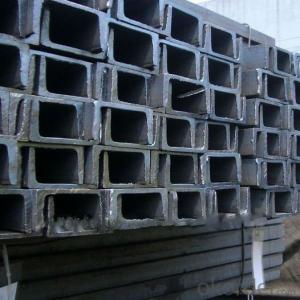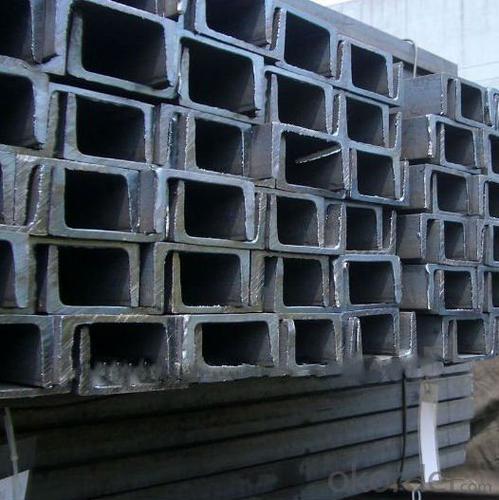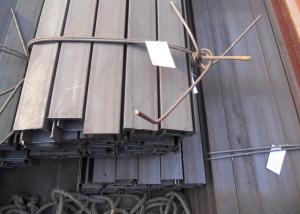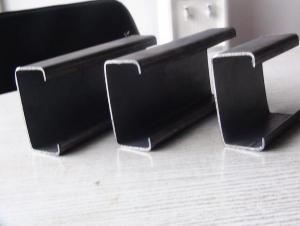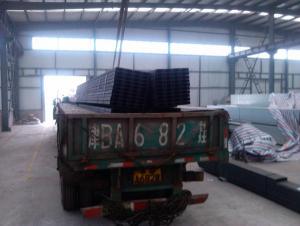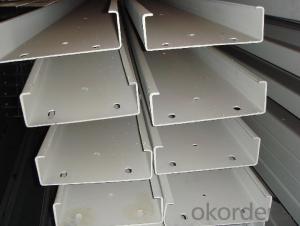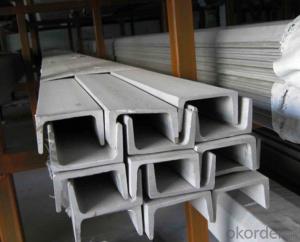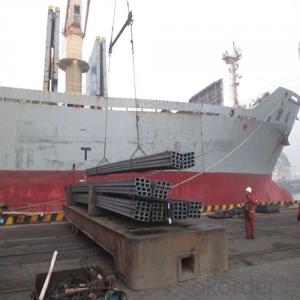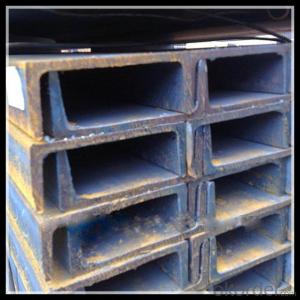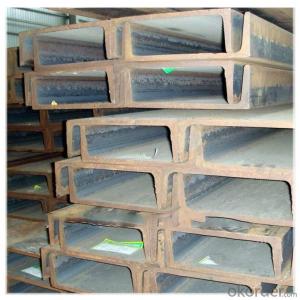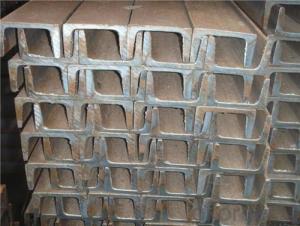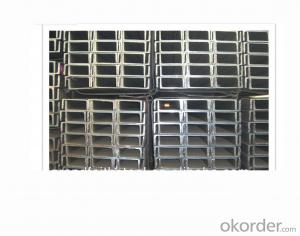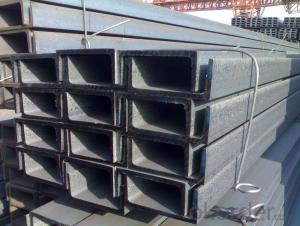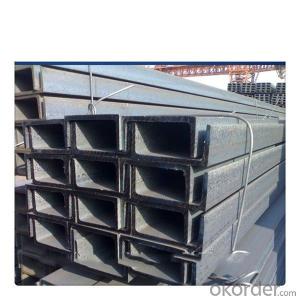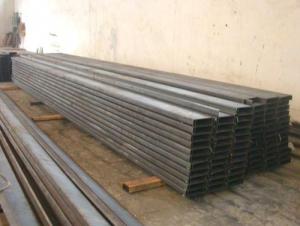Height 88mm the Thickness 8mm Surface and Length: according to the requirements of Channel Steel
- Loading Port:
- Qingdao
- Payment Terms:
- TT OR LC
- Min Order Qty:
- 10 m.t.
- Supply Capability:
- 100000 m.t./month
OKorder Service Pledge
OKorder Financial Service
You Might Also Like
Height 88mm the Thickness 8mm Surface and Length: according to the requirements of Channel Steel
U Channel Steel the Length Thickness According to the Customer
1、the details information of our Channel Steel
1)the ordinary model
Height: | 90-400mm |
Thickness: | 9-14.5mm |
Surface: | according to the customers’ requirements |
Length: | As customers’ requirements |
Size: | 90*37*4.5mm--400*104*14.5 mm . |
Punch: | Can be punched as customer's drawing |
Material: | Q195/Q235/ Q215/Q345/SS400/S235JR, A36,SS400,SS540 ASTM A36 and so on |
2)the light model
Height: | 90-400mm |
Thickness: | 6.4-8.0mm |
Surface: | Painted or Galvanized;according to the customers’ requirements |
Length: | As customers’ requirements |
Size: | 50*32*4.4mm--400*115*8.0mm . |
Punch: | Can be punched as customer's drawing |
Material: | Q195/Q235/ Q215/Q345/SS400/S235JR, A36,SS400,SS540 ASTM A36 and so on |
2、the Product Advantage
1) We can design the channel steel according to customers’requirements
2) We can manufacture under complete quality control system---ISO9001&SGS
3) We can installed with instruction of experienced engineers
4) Easy to assemble and dismantle
5) Eco-friendly material: can be used for several times and can be recycled
6) Shorter construction period, longer using time
7) High strength and stiffness, high weight bearing.
3、why choose us ?Product Advantage
1)The channel steel quality is prime quality
2)Our price is competitive price with our competitor
3)We provide the professional service
4)Prompt delivery & Seaworthy packing
5)Mill Test Certificate
Company Information
which is one of the largest manufacturing bases of Steel Channel in northern China. We are a company that is specialized in producing Stainless Steel Channel、Prime Stainless Steel Channels and so on.
With years of development, our company won the trust and excellent reputation of customers for the quality of our products and sincere service, as well as foreign users of the community.
Please contact me if you are interested in our products and I will try my best to offer you the best goods and service.
- Q: How do you calculate the deflection of steel channels?
- The deflection of steel channels can be calculated using the formula for beam deflection, which takes into account factors such as the material properties, dimensions, and applied load. This formula typically involves the use of equations derived from structural engineering principles, such as the Euler-Bernoulli beam theory or the Timoshenko beam theory. By plugging in the relevant parameters into the appropriate equations, one can determine the deflection of steel channels under specific loading conditions.
- Q: What are the different types of fasteners used for steel channels?
- Steel channels can be fastened using a variety of fasteners. 1. Fasteners like bolts offer a common and reliable option. They come in different sizes and materials, such as stainless steel, carbon steel, and galvanized steel. Bolts typically have a threaded shank and can be secured with a flat head or a nut. 2. Another popular choice is screws, which have a threaded body and a pointed tip. Self-tapping screws are often used with steel channels as they can create their own threads without the need for pre-drilling. 3. Nuts and washers can be used in combination with bolts to enhance stability and prevent loosening over time. Nuts are threaded and can be tightened onto the bolt, while washers distribute the load and protect the channel's surface. 4. Rivets are permanent fasteners commonly used for joining steel channels. They consist of a cylindrical shank with a head on one end and a tail on the other. The tail is inserted through pre-drilled holes and then deformed to create a secure connection. 5. Welding is a specialized method that involves melting the edges of steel channels together to create a strong and permanent connection. It is often used in structural applications that require high strength and rigidity. These examples showcase the various types of fasteners available for steel channels. The selection of the appropriate fastener depends on factors like load requirements, channel type, desired permanence, and available tools. Consulting with professionals is crucial to ensure the right fastener is chosen for each specific application.
- Q: Can steel channels be used in the construction of fencing or barriers?
- Certainly, fencing or barriers in construction can indeed utilize steel channels. Steel channels, being versatile and robust structural components, possess the ability to provide the necessary support and stability demanded by fencing and barrier systems. These channels can be employed to establish a framework for the fence or barrier, furnishing a sturdy structure to firmly hold the fencing material or panels in place. Moreover, steel channels exhibit durability and resistance to weather and corrosion, rendering them fitting for outdoor applications. They can be conveniently tailored to suit specific design requirements and are obtainable in various sizes and thicknesses, accommodating diverse fencing or barrier needs. Furthermore, steel channels can be welded, bolted, or secured using alternative fastening techniques, guaranteeing a secure and enduring fence or barrier system.
- Q: What are the different types of connections for steel channels in modular construction?
- Some of the different types of connections for steel channels in modular construction include bolted connections, welded connections, and bracket connections.
- Q: Can steel channels be used for column supports?
- Yes, steel channels can be used for column supports. Steel channels are often used in construction for their strength and durability. They provide structural support and stability for columns by distributing the load evenly. Steel channels can be welded or bolted together to create a strong and rigid framework for the columns. Additionally, steel channels can be easily customized and cut to the desired length, making them suitable for various column support applications.
- Q: What are the common safety considerations in the design of steel channels?
- Some common safety considerations in the design of steel channels include ensuring proper load-bearing capacity, structural stability, and resistance to deformation or buckling under applied loads. Additionally, factors such as corrosion resistance, fire resistance, and overall durability are also important to ensure the long-term safety and performance of steel channels. Adequate measures must be taken to prevent any potential hazards related to sharp edges, exposed fasteners, or other potential injury risks. Proper installation techniques and adherence to industry standards and codes are essential to ensure the safety of steel channel systems.
- Q: How do steel channels perform in high-vibration areas?
- Steel channels are known for their excellent strength and durability, which makes them suitable for various applications. When it comes to high-vibration areas, steel channels perform exceptionally well due to their inherent stiffness and rigidity. Vibration can cause structural instability and damage to weaker materials, but steel channels have the ability to effectively absorb and dissipate vibrations. This is especially important in areas such as industrial settings, bridges, or heavy machinery installations where vibrations are often present. Steel channels are designed to resist deformation and maintain their shape under dynamic loads, including vibrations. They have high torsional and bending stiffness, which helps to minimize deflection and maintain structural integrity. This ensures that the channels can effectively withstand the constant and repetitive vibrations without compromising their performance. Additionally, steel channels can be further enhanced with vibration dampening techniques. These techniques involve using specialized materials or coatings that are specifically designed to absorb and reduce vibrations. By incorporating such measures, steel channels can effectively mitigate excessive vibrations, ensuring the safety and longevity of the structure. In summary, steel channels are an excellent choice for high-vibration areas due to their inherent strength, rigidity, and ability to absorb vibrations. Their superior performance under dynamic loads, coupled with potential vibration dampening techniques, makes them a reliable and durable solution in such environments.
- Q: Can steel channels be used for exhibition stands?
- Yes, steel channels can be used for exhibition stands. They provide a strong and durable framework that can support various display materials and structures. Steel channels offer stability and versatility, making them suitable for creating customized exhibition stands of different shapes and sizes.
- Q: How do steel channels contribute to building envelope durability?
- There are several ways in which steel channels contribute to the durability of the building envelope. Firstly, they are commonly utilized in constructing the structural frame of the building, providing strength and stability. This ensures that the building can withstand external forces like wind, earthquakes, and heavy loads, thus enhancing its durability. Furthermore, steel channels are often used in the installation of cladding systems, which are essential for the building envelope. Cladding systems protect the building from rain, snow, and UV radiation. The steel channels support the cladding panels, ensuring proper installation and alignment, which helps maintain the overall integrity and durability of the building envelope. In addition, steel channels have high resistance to corrosion, which is crucial for the long-term durability of the building envelope. Corrosion can weaken the building's structural components and compromise its stability. By using steel channels that are coated or galvanized to prevent corrosion, the building envelope is better protected against environmental factors that could lead to deterioration over time. In conclusion, steel channels play a vital role in enhancing the durability of the building envelope. They provide structural strength, support cladding systems, and resist corrosion. These qualities contribute to the longevity and sustainability of the building, ensuring it remains functional and safe for many years.
- Q: Are steel channels suitable for swimming pool installations?
- No, steel channels are not suitable for swimming pool installations as they are prone to rust and corrosion when exposed to water and chemicals.
Send your message to us
Height 88mm the Thickness 8mm Surface and Length: according to the requirements of Channel Steel
- Loading Port:
- Qingdao
- Payment Terms:
- TT OR LC
- Min Order Qty:
- 10 m.t.
- Supply Capability:
- 100000 m.t./month
OKorder Service Pledge
OKorder Financial Service
Similar products
Hot products
Hot Searches
Related keywords
